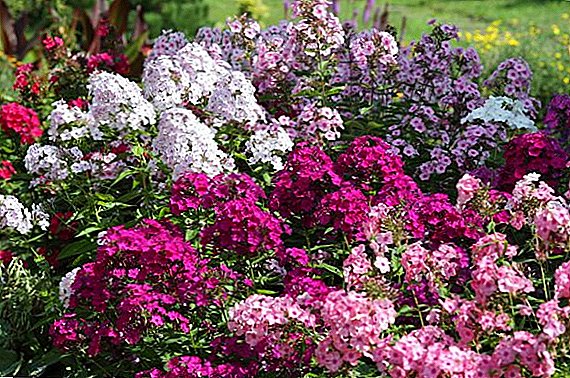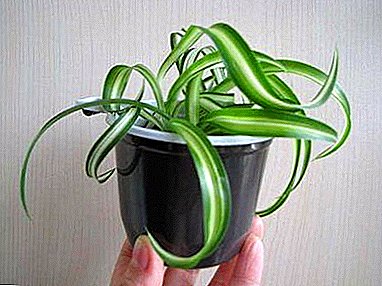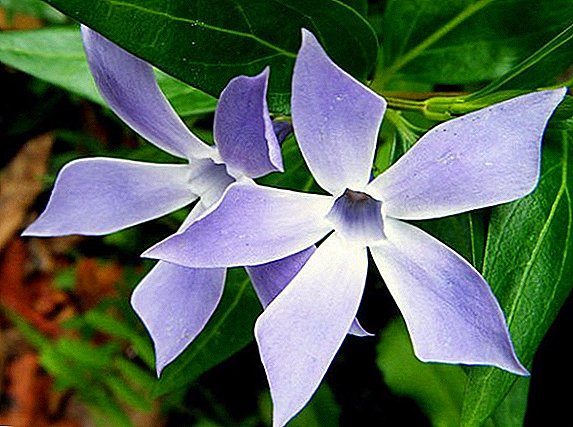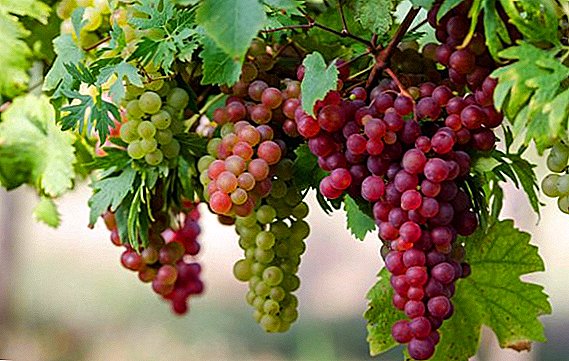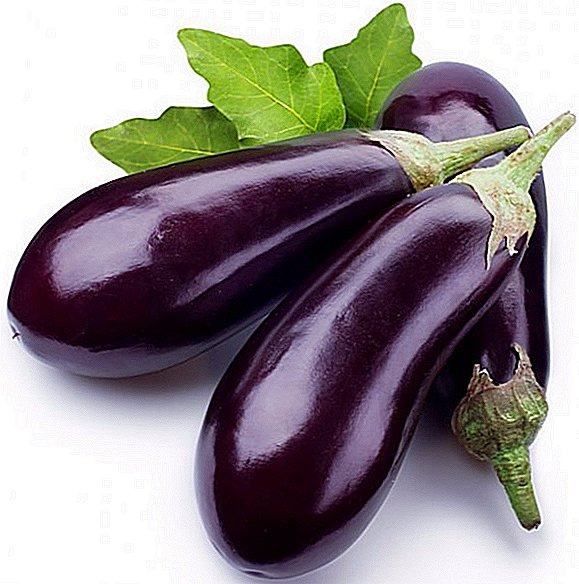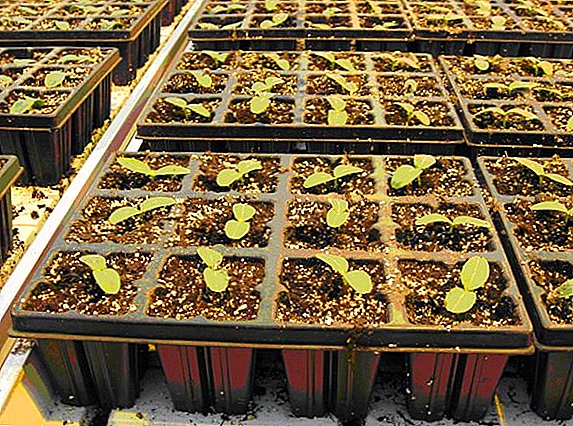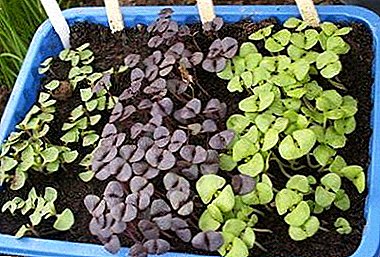
Basil is valued for its unique spicy flavor and healthy properties. Planting basil seedlings in open ground - transfer of grown seedlings to a permanent place.
This stage is important for the spices no less than the sowing of seeds: the spice harvest, its growth and development directly depend on the correctly chosen area and correctly implemented transplant.
It is only important to know the rules of planting this plant, to provide him with proper care. On all the intricacies of planting basil seedlings on the beds and will be discussed in this article.
When can I plant?
 Duration of growing seedlings from basil seeds averages 45 - 60 days, depending on the variety of spicery (maturing early ripening varieties (35 - 45 days), mid-ripening (55 - 70 days) and late (75 - 90 days) since the appearance first shoots.
Duration of growing seedlings from basil seeds averages 45 - 60 days, depending on the variety of spicery (maturing early ripening varieties (35 - 45 days), mid-ripening (55 - 70 days) and late (75 - 90 days) since the appearance first shoots.
Completely ready for planting is considered to be seedlings that look stocky and healthy., with a well-developed root system and a thick, durable stalk, with several (5 - 6) strong leaves of bright saturated color, typical of a particular variety.
Temperature
The term of planting basil seedlings in open ground depends on several factors, the main ones being weather conditions: since basil is a very thermophilic plant, the average air temperature should not fall below + 15C, and the threat of return frost should completely disappear.
If seedlings are planted ahead of time, even a short-term decrease in temperature can inflict irreparable harm on young plants.
Month of the year
For different regions of Russia, the establishment of such weather conditions is peculiar to different time periods.
- In Central Russia, in the Moscow region. This latitude is characterized by warm and sunny April, but one should not hurry up with the landing of the "southern" spice, since frosts and even precipitations in the form of snow replace the bright sun. The optimal landing time is the end of May - the beginning of June. The first time you can insure still fragile plants, arranging for them a daily shelter for the night agrofibre or film.
- In Siberia and the Urals. Siberia and the Urals are regions with a rather harsh climate: it will be difficult for a heat- and light-loving plant to adapt to such weather conditions and at the same time to give a full-fledged harvest. Therefore, gardeners of this region is better not to risk and plant their seedlings in a greenhouse or greenhouse. This can be done in May and June, focusing on the condition of the seedlings.
A place
For the cultivation of basil is ideal plot, which is well lit (southern and south-western sector) and protected from wind and drafts (along fences or close to outbuildings, you can, along with higher plants). Spice does not tolerate a permanent place, every year its location must be changed. Spice grows well after crops such as onions, early and middle cabbage, cucumbers, beets, tomatoes, potatoes, not the best option - carrots, late cabbage.
Basil is often called the "antibiotic" for the garden for his ability to have a beneficial effect on other vegetables and the ability to heal the environment. The spicy aroma of the plant serves as a repellent for tomatoes, onions, peppers, cucumbers and cabbage, successfully scaring whitefly and aphids. Also, the spice planted along the tomatoes, will not allow mold and powdery mildew on the seedlings.
Soil preparation and composition
 Basil grows well in loose, well-drained and nutritious soil. If the soil on the plot does not have the above properties, then it is advisable to carry out a number of activities for its preparation.
Basil grows well in loose, well-drained and nutritious soil. If the soil on the plot does not have the above properties, then it is advisable to carry out a number of activities for its preparation.
- In autumn, the site is dug up to a depth of 25 cm.
- When digging, organic fertilizers (humus, manure, compost) are applied at the rate of 2 - 2.5 kg per m 2, also mineral: superphosphate (40 - 50 grams per m2) and potassium salt (10 - 15 grams per m2).
- In the spring, the area is loosened to a depth of 10 to 12 centimeters, you can add coarse-grained sand or peat (1 -2 bags of 25 kilograms per bed) to give the soil lightness and friability.
Step by step algorithm of action
Next, we present step by step instructions on disembarkingand also we will answer the question that excites many gardeners: can the plant be buried during planting?
- Two weeks before transplanting to the open ground, it is necessary to start carrying out “tempering procedures”: take out containers with young plants to the open air (temperature - not lower than + 10С), increasing the residence time every day.
- Prepare the holes by digging them in one row or in a checkerboard pattern. The distance between them is 20 - 25 centimeters, between the rows it is necessary to retreat 25 - 30 centimeters. The depth of the landing fossa - 10 centimeters.
- On the day of planting (it is better if it is cloudy or in the evening), the wells must be properly shed (1 liter of warm distilled water per 1 well).
- Containers with seedlings should be moistened abundantly to avoid injury to the root system when removing it from the container.
- The plant is carefully removed from the tank, the ground with the roots do not need to shake.
- Together with the earthy clod, the sprout of the basil is placed in the center of the hole, and, deepening the plant to the first bud (place of the cotyledon leaves), is covered with soil.
- The earth around the stem should be gently pressed to better fix the future bush.
- The plant must be watered again.
How to care after landing?
The scheme of care for planted seedlings of basil is standard and includes regular watering, loosening, dressing, nipping.
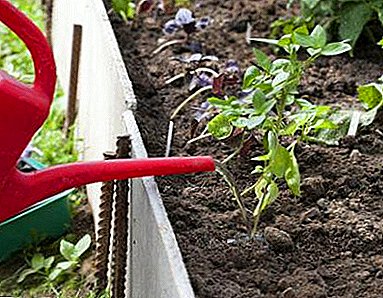 After planting seedlings in open ground, basil should be watered daily (0.5 - 1 liter per bush) until it is fully engrafted. Then watering should be regular, as the topsoil dries.
After planting seedlings in open ground, basil should be watered daily (0.5 - 1 liter per bush) until it is fully engrafted. Then watering should be regular, as the topsoil dries.You should not water the plant from the hose with tap water, better - well settled and warmed up in the sun (up to + 25C). Basil perfectly responds to watering, carried out by the drip method. After watering, the soil around the bush should be loosened in order to avoid the formation of a dry peel and the appearance of weeds (up to 7 times during the whole growing season).
- With the appearance of yellowed foliage and after each cut, basil should be fed. For these purposes, suitable both organic and mineral fertilizers: mullein (1:10), chicken manure (1:20), solutions of nitrophoska (2 tablespoons per 12 liters of water) or ammonium nitrate (1.5 tablespoons on 1 liter of water).
- When the basil grows to 20 cm, it is necessary to pinch the top, if this has not been done before. Inflorescences that appear during the summer should be removed. These activities will stimulate branching and the appearance of lush greenery.
Subject to compliance with all the requirements that a thermophilic plant makes to care and cultivation, you can enjoy the spicy aroma and juicy greens all summer. And, having dried the leaves, even in the winter hot summer days will be remembered.


 After planting seedlings in open ground, basil should be watered daily (0.5 - 1 liter per bush) until it is fully engrafted. Then watering should be regular, as the topsoil dries.
After planting seedlings in open ground, basil should be watered daily (0.5 - 1 liter per bush) until it is fully engrafted. Then watering should be regular, as the topsoil dries.